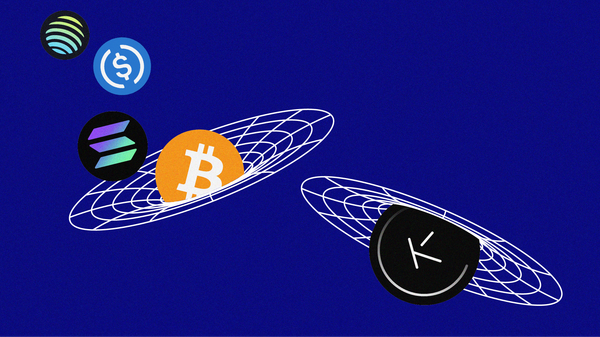Vertex's Edge in the Market
A differentiating liquidity solution in a sea of derivatives protocols.
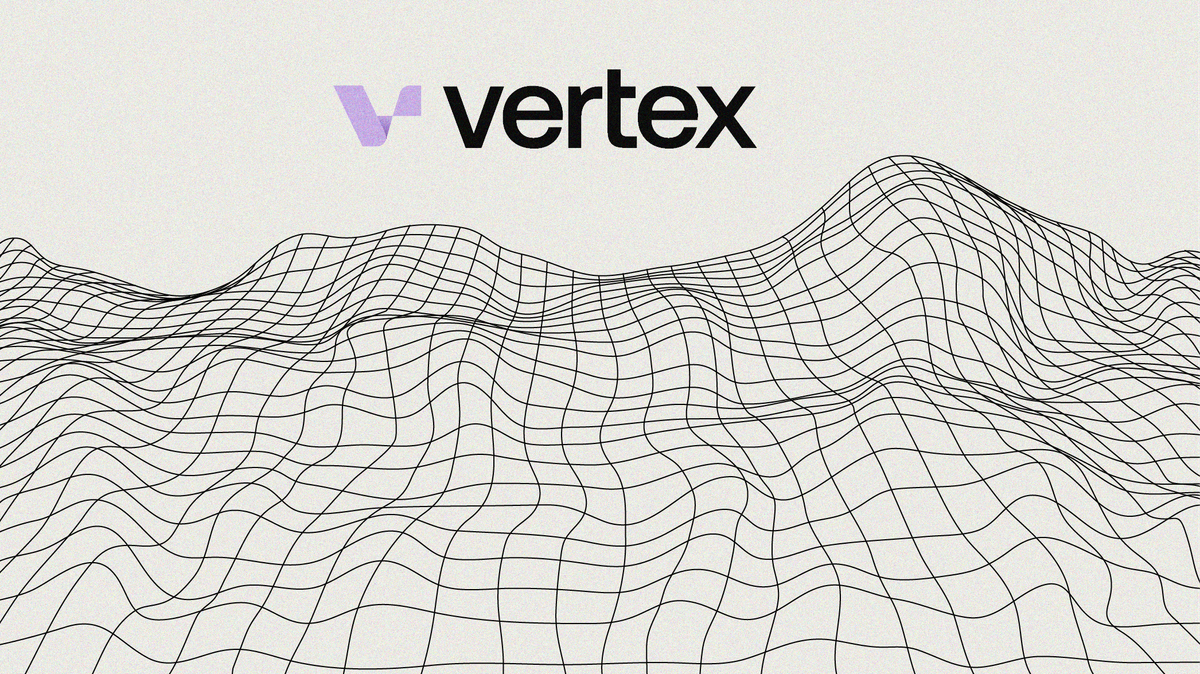
Disclosure
This report is made in collaboration with Vertex and is therefore sponsored. All editorial decisions, opinions, and conclusions expressed are entirely those of our own and remain independent of any external influence.
Facilitating a trading venue is an extremely lucrative endeavor, attracting a plethora of well-capitalized and knowledgeable opportunists, thus making it fiercely competitive as exchange operators fight tooth-and-nail for market share. The odds of becoming a mainstay for volume are slim, but if relative success is achieved, the dividends more than compensate for the tremendous effort and resources required to engage in this type of business activity.
Introduction
Repeatedly, we’ve witnessed the great lengths to which exchanges go to stay ahead. Shady backroom deals and morally or ethically questionable business practices are standard issued tools in the arsenal of many centralized entities. The worrisome lack of transparency has allowed numerous misdeeds to go unnoticed or simply be swept under the rug. Coupled with custody concerns, stemming from the frequent and blatant misuse of entrusted customer funds, traders have slowly started to venture on-chain after realizing that regulatory interventions and social media boycotts seem to be inefficient catalysts for change.
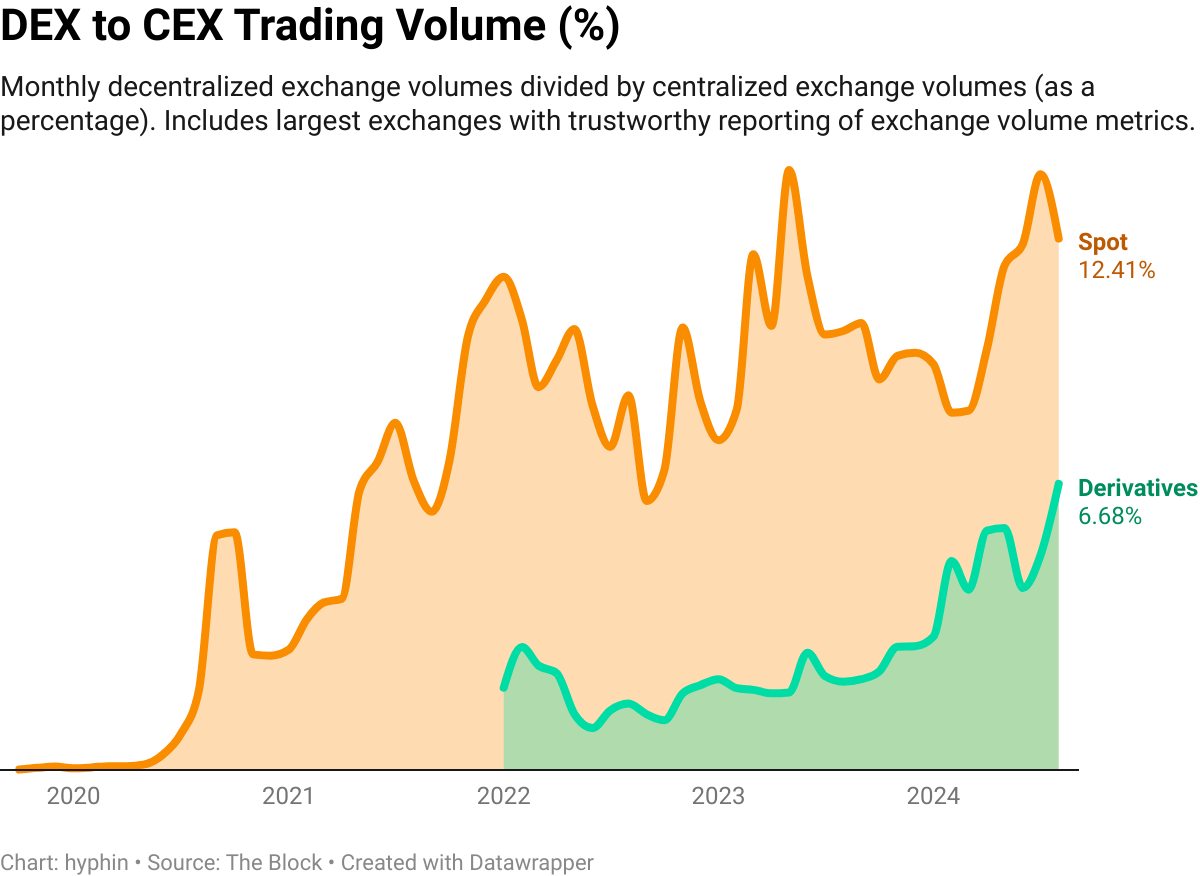
In recent years, following increased adoption, advancements in infrastructure scalability, and efficient protocol modeling, usage metrics and volume for their decentralized counterparts have increased tremendously. Although they provide significantly more visibility, access to exotic assets, reduced counterparty risk, and no need for identification, they still face a unique set of challenges, particularly in the realms of user experience and liquidity, among others. Solutions to innate pitfalls usually determine the relevance of a DEX as even the slightest technical advantages are more pronounced due to most protocols being fairly indistinguishable in terms of functionality. Vertex has emerged as a strong example of this, and our focus will be on how it has successfully navigated these hurdles to establish itself in the market.
The Powerhouse
Housing a comprehensive suite of products, Vertex serves as a one-stop-shop for traders with access to spot and perpetual futures trading alongside money markets under one roof on Arbitrum, Mantle, Blast (Blitz) and more recently, Sei. Primarily focusing on derivatives, the protocol accounts for ~8% of the total annual volume generated by the sector's prestigious top 10 across numerous chains.
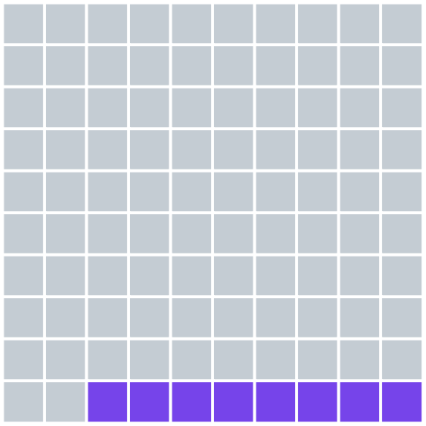
At its core lies a clever hybrid exchange model, fusing a central-limit order book (CLOB) with an automated market maker (AMM), designed to deliver lightning-speed execution times and optimal liquidity, comparable to traditional platforms used by professionals and institutions alike.
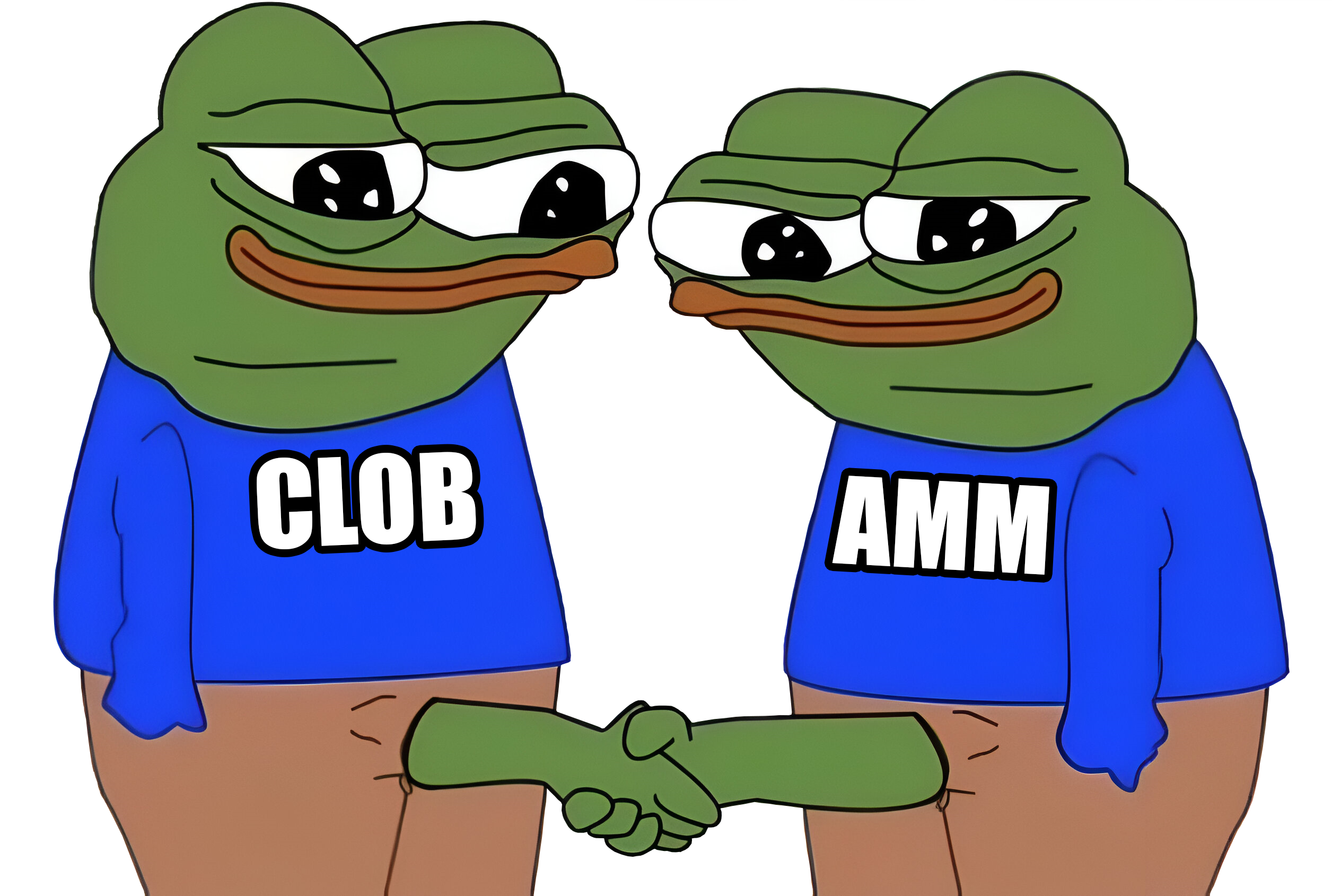
To understand how this implementation truly works, let's break down its key components and map out the delicate intricacies contributing to the efficacy as they play a pivotal role in an upcoming segment.
AMM
Positioned as the protocol's default state, the automated market maker seamlessly merges its liquidity pool with the order book, allowing trades to be executed against a combined liquidity source, therefore guaranteeing the best available prices at any given time. Trading can also take place without depending on the sequencer, a feature referred to as "Slo-Mo Mode", which emulates the experience found on Uniswap or other alternatives.
Sequencer (CLOB)
Residing off-chain as an independent node currently operated by the team (with plans for future democratization), the sequencer is a high-performance order book and trading engine capable of matching orders in an average of 5-15 milliseconds, free from the constraints of on-chain latency. It supports high-frequency trading through a robust, user-friendly API and supplements liquidity by integrating pairwise LP markets. Asset custody remains on-chain, preventing the sequencer from controlling or censoring trades. Additionally, Vertex offers miner extracted value (MEV) protection and conducts risk checks at the sequencer level to minimize transaction costs, while other actions require on-chain validation.
It's evident that the tech stack is industry-grade and verifiably so, but ultimately large scale usage is driven by the traders interacting with the web application rather than software development kits. Shallow or not, majority of users often times care very little for the foundation of which a product is built and base their actions on what they see and how it makes them feel. The importance of a cohesive interface cannot be understated. Aesthetics, ease of use and even tiny quality-of-life functions matter as the purpose of a proper front-end should be to abstract away all the complex logic under the hood. With these considerations in mind, Vertex has placed a great deal of thought on user experience by introducing universally cross-margined accounts, where a user's entire portfolio serves as collateral, offsetting margin requirements across multiple positions. Unlike isolated margin, which limits risk to the margin of a single position, cross-margining allows liabilities to be shared across a single address, reducing the risk of liquidation and lowering margin requirements. The platform also automates risk management, optimizes capital efficiency, and offers a seamless interface for managing positions. This setup benefits traders by eliminating the need for switching between accounts and enabling more efficient trading strategies like basis trades.
Trading aside, for those not interested in getting chopped up in the books by the invisible hand, are presented with various yield options. Staking the native token to earn a portion of trading fees generated by the protocol, providing liquidity to pools, utilizing the money market to either supply/borrow assets or depositing into ecosystem vault(s). The latter being a new addition featuring automated strategies from affiliated projects like Skate Finance and soon enough, Elixir.
Edge
Liquidity fragmentation poses a serious issue for blockchain economies and its effects are becoming increasingly apparent as new layers enter the market by the dozen, often times with irresistible incentives programs. Given that loyalty in this industry isn't rewarded, hordes of capital flood to bridges, further intensifying dilution. This effectively forces builders to deploy on a multitude of chains to broaden their addressable market. As a result, in the context of trading venues, daily volume is scattered, with no single network serving as the dominant originator.
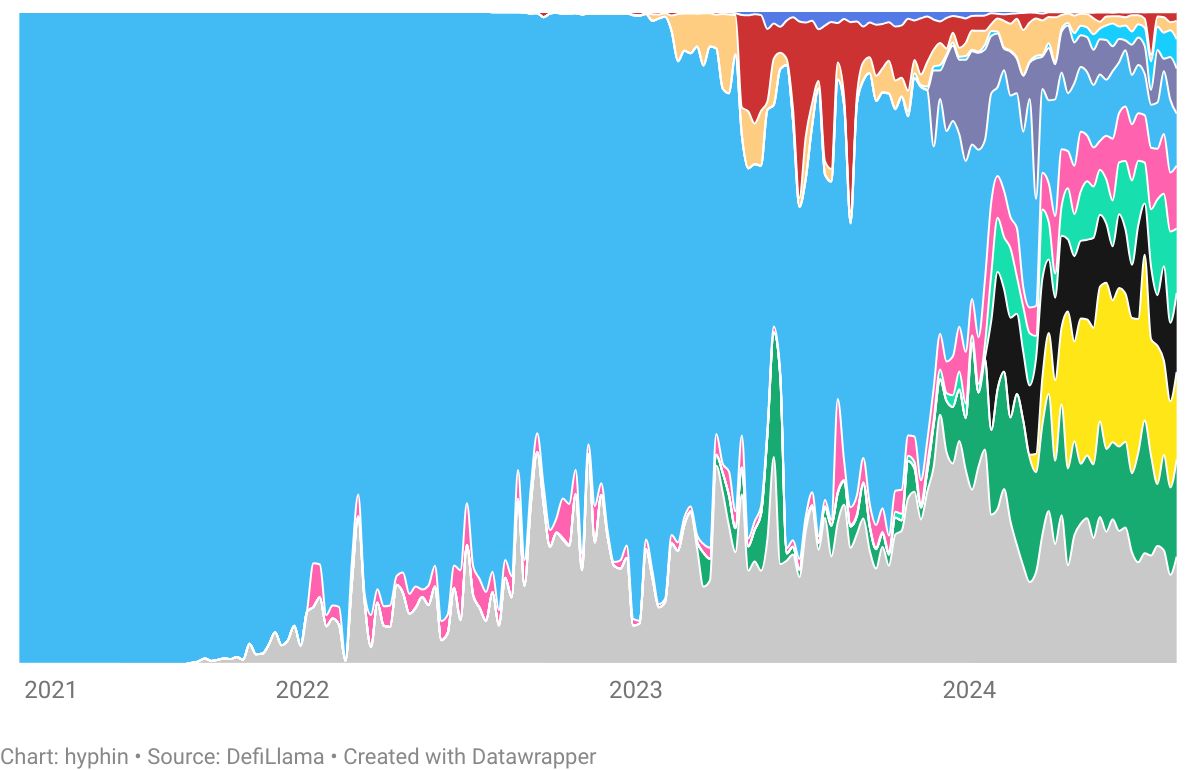
While Ethereum (L1) used to be the primary hub for perpetuals, it has now been overtaken by a vast array of superior roll-ups and layer-1s more suited for these dApps. Establishing a simultaneous presence is ideal for visibility, but it comes at the expense of less efficient individual markets, which are subject to increased volatility and slippage.
To counteract this, Vertex has taken the approach of intertwining liquidity across all separate instances rather than consolidating it in a single environment (e.g. custom app chain). This is achieved through Edge, a cutting-edge synchronous order book liquidity product designed to unify cross-chain liquidity across multiple networks, eliminating the need for external third-party bridges. It enhances the existing trading engine by aggregating liquidity from different chains into a single, unified order book, managed by the sequencer. This novel mechanism allows for efficient order matching and settlement across several blockchain deployments without fragmenting liquidity or potentially forgoing ecosystem rewards.

Edge functions as a virtual market maker, enabling trades across a variety of chains while upholding its advertised low latency and high performance. By synchronizing liquidity, it optimizes market depth, reduces slippage, and provides a seamless trading experience, supporting spot, perpetual and money markets. Raising blockspace demand, improving on-chain liquidity, and lowering development costs for operators collectively make the integration a net positive for both users and the underlying base layers.
Traction
#1 Liquidity
Edge is live on two different protocols across four different chains. Specifically, Blitz on Blast and Vertex on Arbitrum, Mantle and Sei. Across these fours networks, Edge has amassed over $100m in Total Value Locked with more than 75% of this residing on Arbitrum. With the latest integrations of Sei and Mantle, Edge is on the path to offer deep perp liquidity across a wide variety of ecosystems.

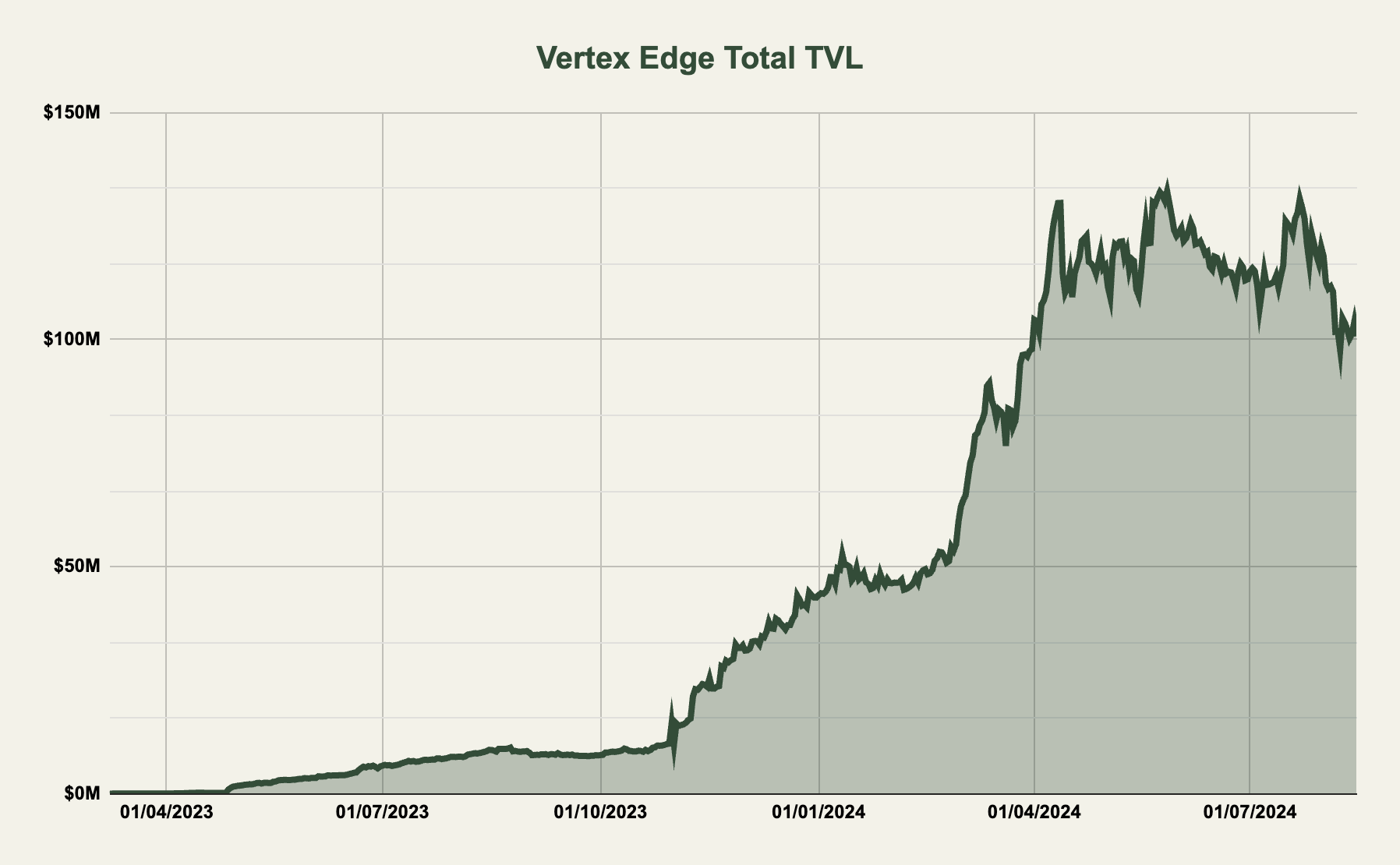
Liquidity deposited into Vertex acts as more than idle collateral used for perp trading. Specifically, assets can be added to the AMM liquidity pools in which the liquidity remains as usable margin for perpetual futures trading. Margin deposited can additionally be borrowed against via Vertex' in-house lending market. As seen in the pie chart below, the majority of assets deposited into Edge protocols (Vertex and Blitz) are wBTC, wETH and stablecoins, USDC, USDB and USDT.
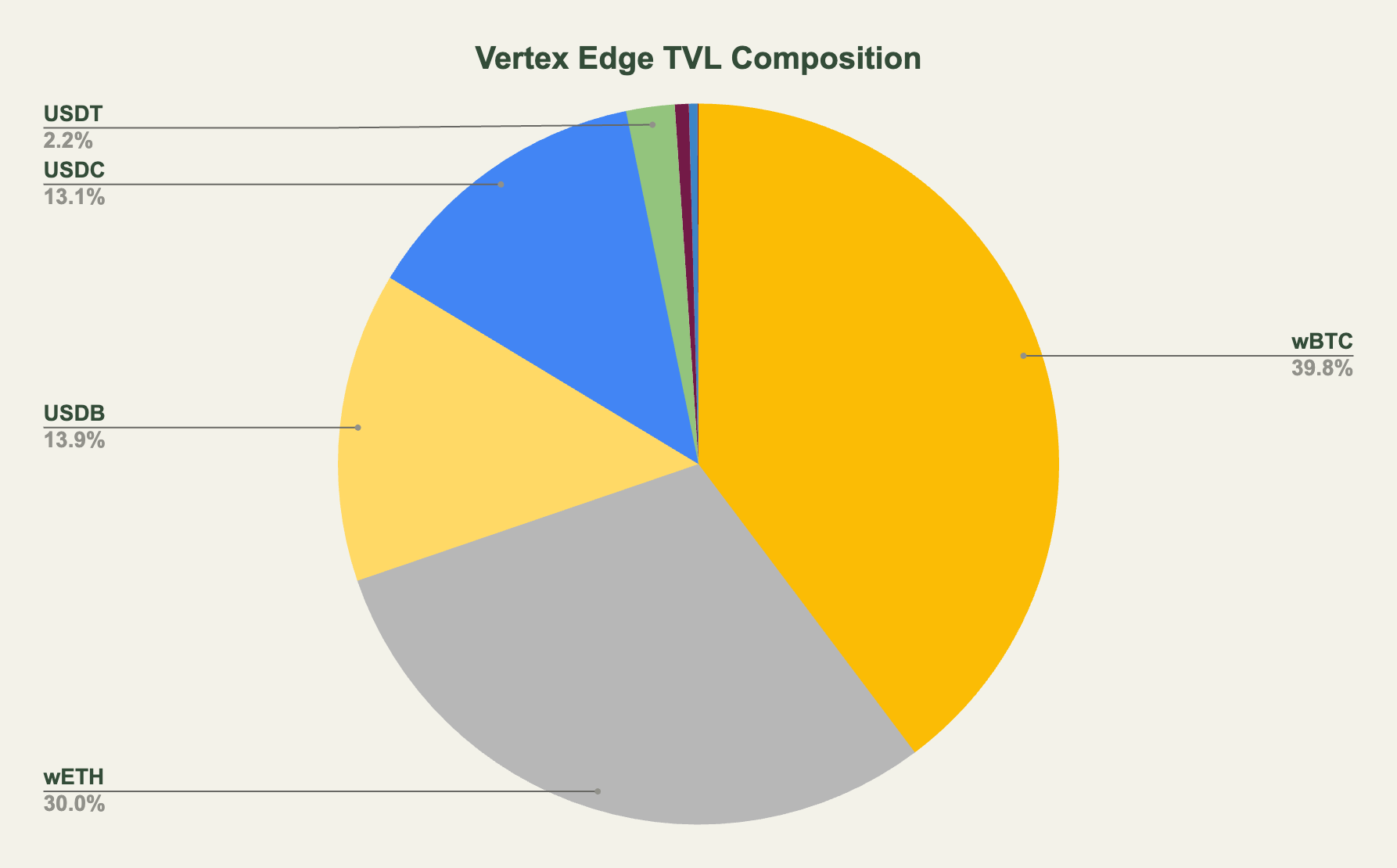
#2 Volume
Edge markets have facilitated more than $130b in trading volume since last year across all four chains. Users can trade over 50 different pairs cross-margin with up to 20x leverage on BTC and ETH and 10x leverage on altcoins. With over $2b in volume the past week alone, Vertex Edge is one of the largest on chain perpetual futures platforms across all of crypto.
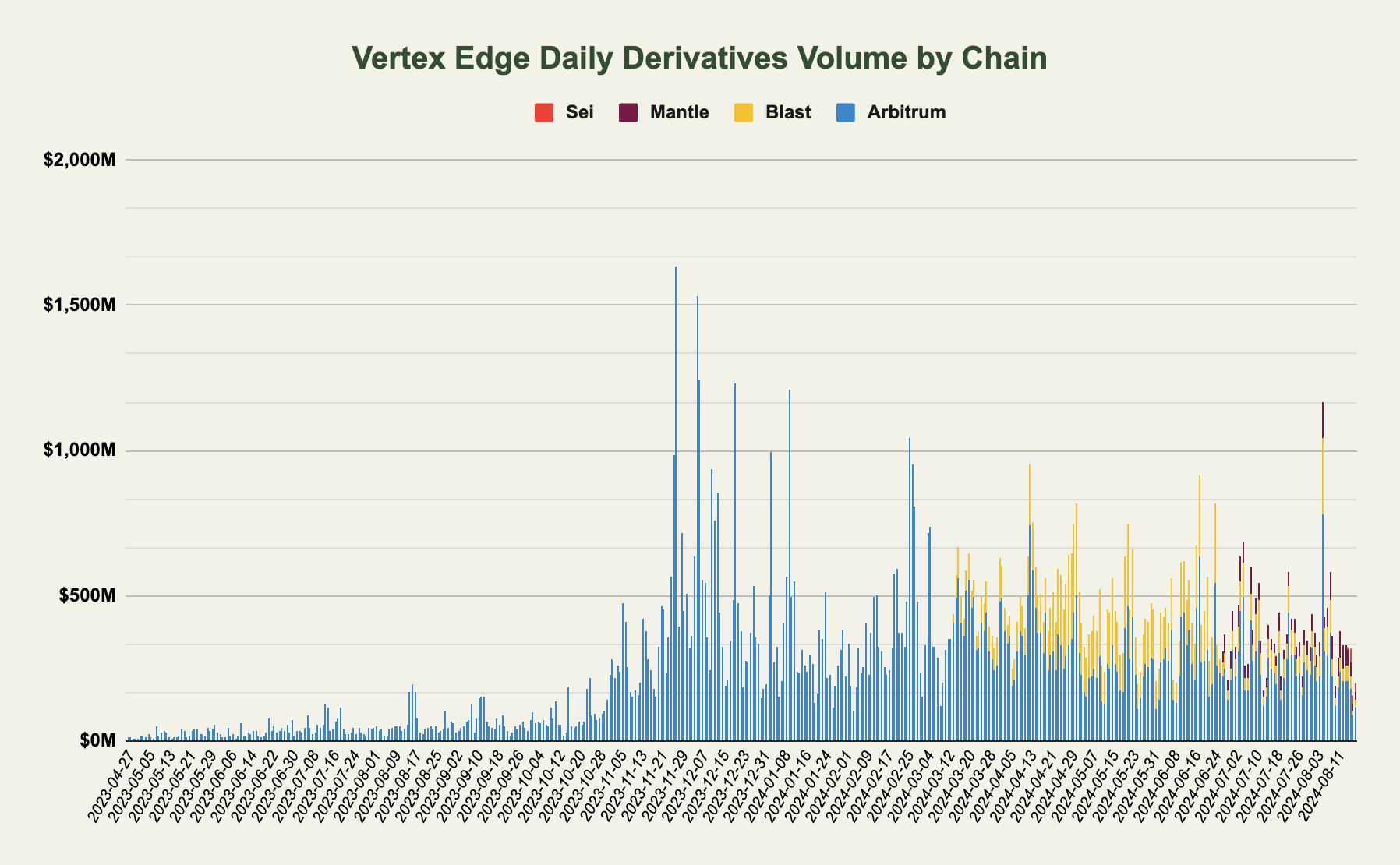
While more than 80% of the historical volume is generated on Arbitrum, a lot of volume today is generated by Blast, Mantle and Sei traders. Today's volume composition as of 19/8/2024:
- Arbitrum: 58%
- Blast: 14%
- Mantle: 13%
- Sei: 15%
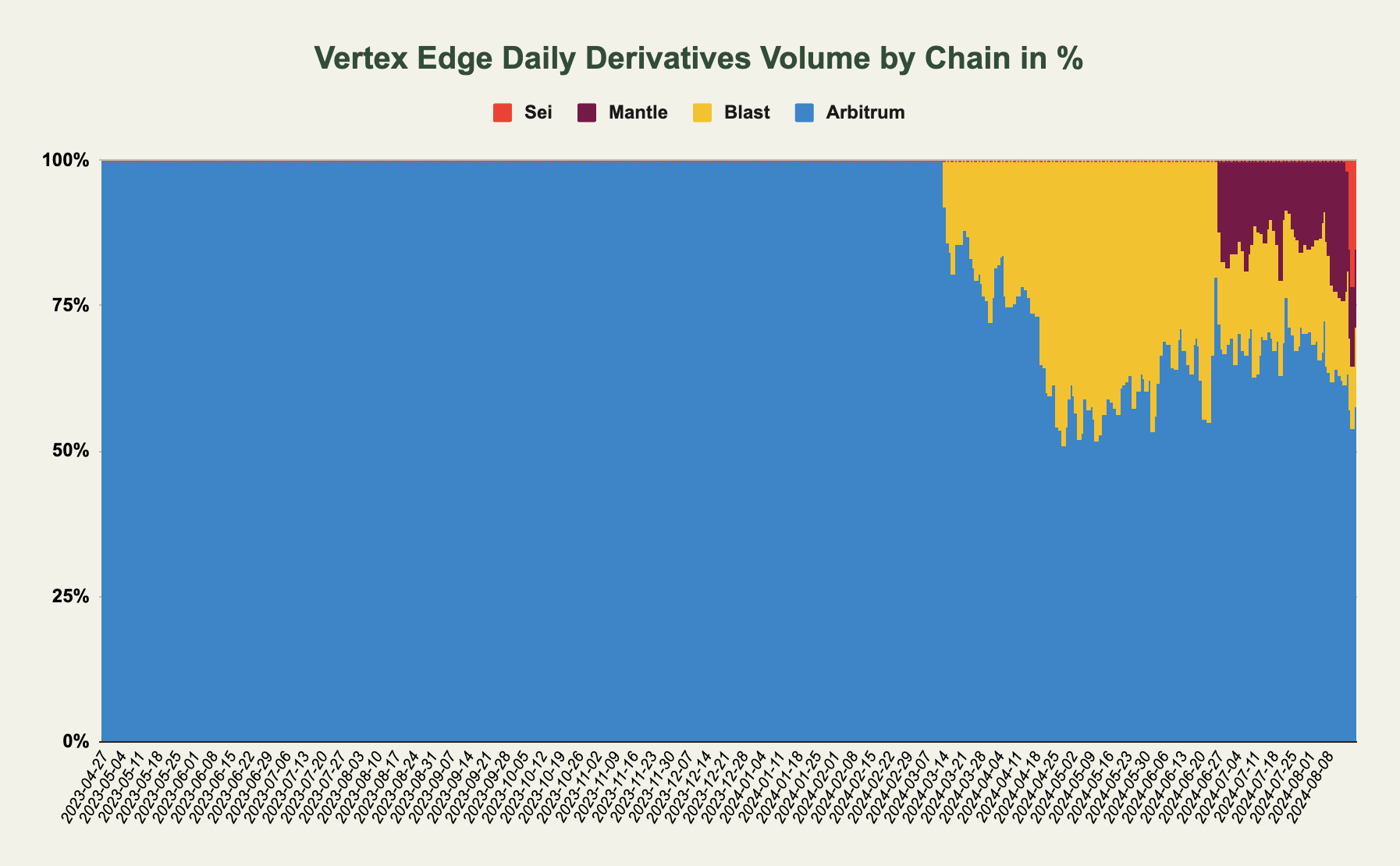
With the launch on Sei, the unified order book liquidity is available to traders on the high-performance parallelized EVM chain. In addition, Sei has allocated a total of 5.1m SEI (850k SEI per week for the next six weeks) to Vertex traders on the Sei blockchain. More info on the rewards can be found here.
#3 Fees & Revenue
Like other on chain exchanges, Vertex captures a fee from traders on the platform. In contrast to other DEXs, the cost to trade on Vertex is minimal and more akin to trading on a centralized venue. Placing limit orders across all Vertex Edge markets (maker) is free whereas market orders (taker) comes with a fee of 2 bps (0.02%). The fees captured by Vertex flow to different protocol participants. For one, fees are used to pay market makers (maker rebates) to incentivize deep liquidity across the order book and AMM as well as lenders on the money market. Fees that are not paid to liquidity providers are earmarked as protocol revenue and is directed to the insurance fund, VRTX stakers and used for operational expenses.
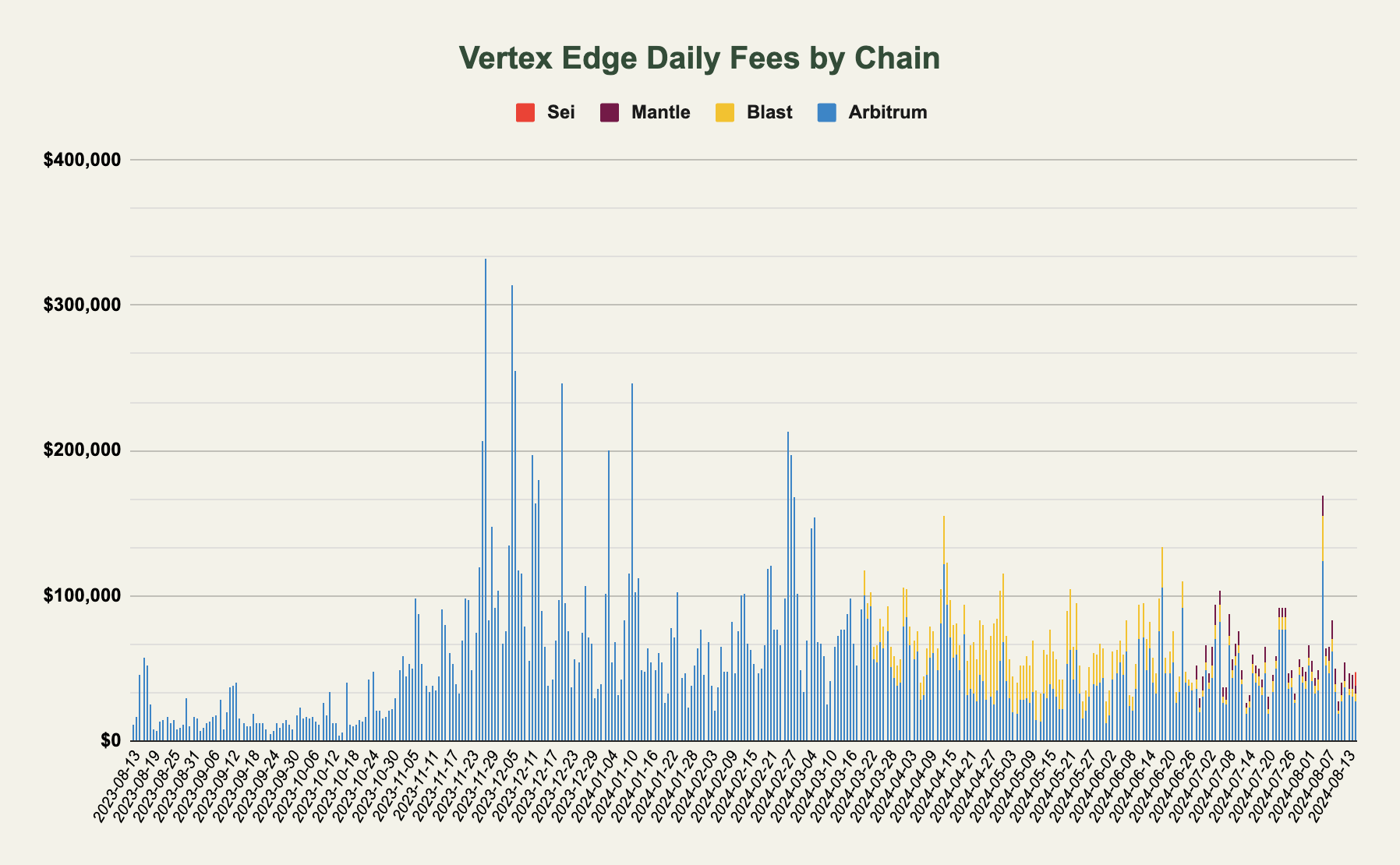
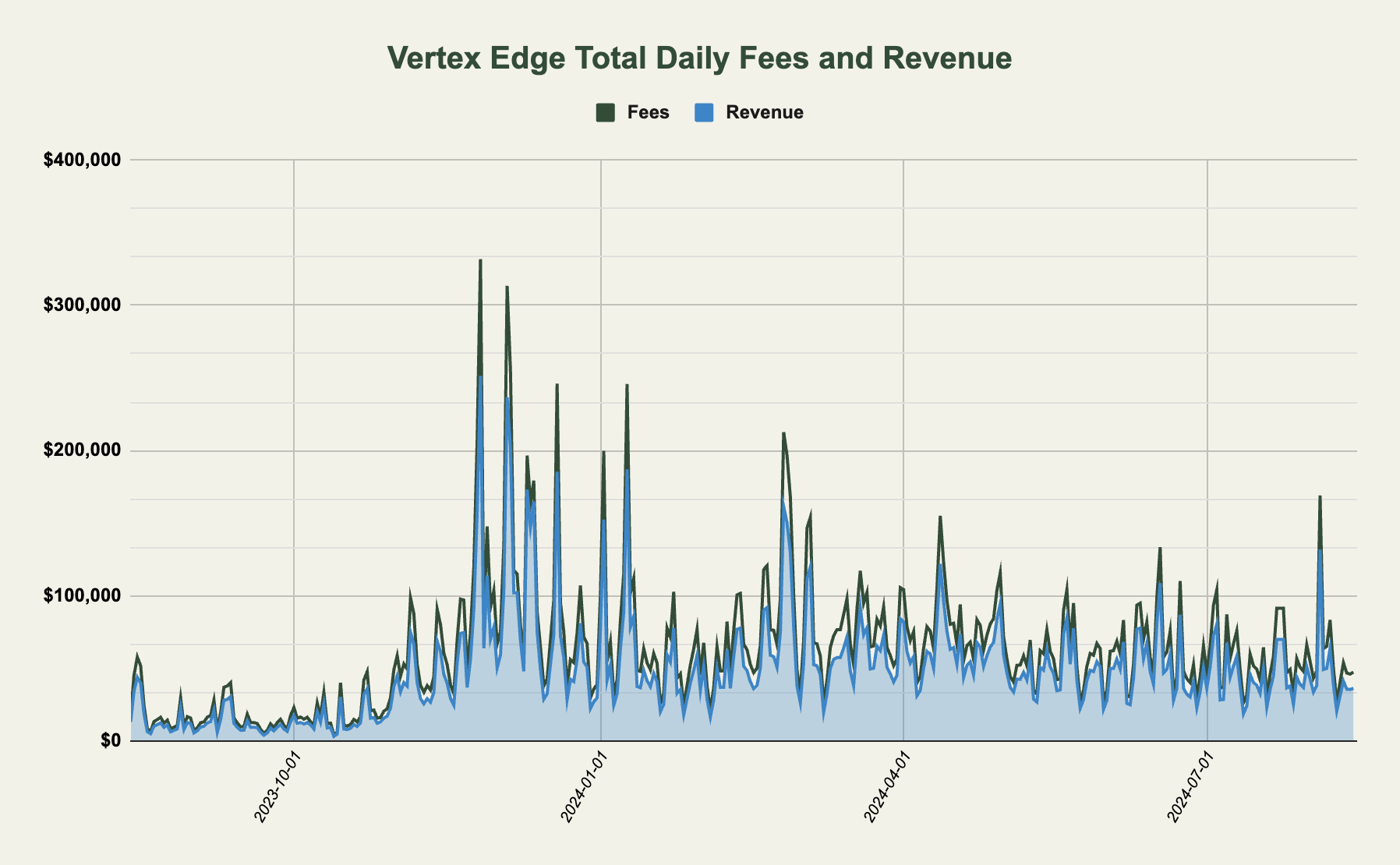
Up to 50% of the revenue generated by Vertex is distributed to VRTX stakers each week. By staking VRTX for longer, users receive a boost of up to 2.5x (staking for 6 months consecutively) on the staking rewards received. The average reward to VRTX stakers is currently at 33% annualized. The specific amount of revenue directed to stakers each week can be found on the Vertex X account.
Finally, a part of the VRTX is emitted to incentivize traders, both market makers and takers. A total of 44% of the VRTX supply has been dedicated as trading rewards. For the exact emission schedule of these rewards, visit the page here. For a full insight into the emission of VRTX to all parties see more here.
Conclusion
Vertex has carved out a strong position in the competitive decentralized exchange landscape by leveraging a hybrid model that combines high-speed execution with robust liquidity management, while also addressing the critical challenges of user experience and cross-chain liquidity. By integrating innovative features like Edge and offering a seamless trading interface, the platform not only enhances trading efficiency but also provides a more secure and user-friendly environment. This approach has allowed Vertex to capture significant market share and establish itself as a leading platform in the DeFi space, demonstrating the importance of technological innovation and user-centric design in achieving success.
Disclaimer
The information provided is for general informational purposes only and does not constitute financial, investment, or legal advice. The content is based on sources believed to be reliable, but its accuracy, completeness, and timeliness cannot be guaranteed. Any reliance you place on the information in this document is at your own risk. On Chain Times may contain forward-looking statements that involve risks and uncertainties. Actual results may differ materially from those expressed or implied in such statements. The authors may or may not own positions in the assets or securities mentioned herein. They reserve the right to buy or sell any asset or security discussed at any time without notice. It is essential to consult with a qualified financial advisor or other professional to understand the risks and suitability of any investment decisions you may make. You are solely responsible for conducting your research and due diligence before making any investment choices. Past performance is not indicative of future results. The authors disclaim any liability for any direct, indirect, or consequential loss or damage arising from the use of this document or its content. By accessing On Chain Times, you agree to the terms of this disclaimer.






